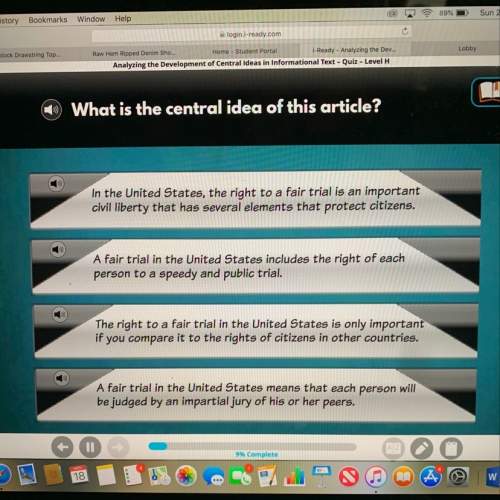
English, 03.08.2019 16:30 princesskoi1910
3. read the following passage and answer the questions that follow. the second amendment to the u. s. constitution, which is a frequent source of controversy in public debates, says that "a well regulated militia, being necessary to the security of a free state, the right of the people to keep and bear arms, shall not be infringed." the controversy stems from the fact that some americans feel that the second amendment guarantees all citizens the absolute right to own firearms, while others believe that some restrictions on gun ownership are consistent with the second amendment. which of the following lists of words from this passage indicates the author's intention? (5 points) a) controversy, debates, believe b) amendment, constitution, citizens c) frequent, public, necessary d) absolute, firearms, restrictions read the following passage and answer the question that follows. tom stoppard's play, rosencrantz and guildenstern are dead, draws on two previous theatrical works: shakespeare's hamlet and samuel beckett's waiting for godot. rosencrantz and guildenstern are dead follows the "off-stage" exploits of two minor characters from hamlet, rosencrantz and guildenstern. while the two main characters in stoppard's play occasionally make brief appearances in "hamlet," as scripted in shakespeare's original tragedy, the majority of the play takes place in other parts of the castle where hamlet is set. while "off stage" in this way, the characters resemble the main characters in the absurdist waiting for godot. as in beckett's play, rosencrantz and guildenstern pass the time by impersonating other characters, engaging in word play, and remaining silent for long periods of time. these same two characters were also featured in a parody of hamlet, the short comic play by w. s. gilbert entitled rosencrantz and guildenstern. gilbert's play makes rosencrantz and guildenstern into central characters and alters the storyline of hamlet. according to this passage, tom stoppard (5 points) a) dislikes shakespeare b) is a playwright c) wants fame d) reads many books answering these 2 questions

Answers: 1


Another question on English


English, 22.06.2019 00:00
The following question is based on your reading of a midsummer night’s dream by william shakespeare. why does puck transform bottom? a. to disrupt the play. c. to scare the mechanicals. b. for revenge on theseus. d. to scare the lovers.
Answers: 1

English, 22.06.2019 04:50
Read the passage, then answer the question that follows. no one could have seen it at the time, but the invention of beet sugar was not just a challenge to cane. it was a hint—just a glimpse, like a twist that comes about two thirds of the way through a movie—that the end of the age of sugar was in sight. for beet sugar showed that in order to create that perfect sweetness you did not need slaves, you did not need plantations, in fact you did not even need cane. beet sugar was a foreshadowing of what we have today: the age of science, in which sweetness is a product of chemistry, not whips. in 1854 only 11 percent of world sugar production came from beets. by 1899 the percentage had risen to about 65 percent. and beet sugar was just the first challenge to cane. by 1879 chemists discovered saccharine—a laboratory-created substance that is several hundred times sweeter than natural sugar. today the sweeteners used in the foods you eat may come from corn (high-fructose corn syrup), from fruit (fructose), or directly from the lab (for example, aspartame, invented in 1965, or sucralose—splenda—created in 1976). brazil is the land that imported more africans than any other to work on sugar plantations, and in brazil the soil is still perfect for sugar. cane grows in brazil today, but not always for sugar. instead, cane is often used to create ethanol, much as corn farmers in america now convert their harvest into fuel. –sugar changed the world, marc aronson and marina budhos how does this passage support the claim that sugar was tied to the struggle for freedom? it shows that the invention of beet sugar created competition for cane sugar. it shows that technology had a role in changing how we sweeten our foods. it shows that the beet sugar trade provided jobs for formerly enslaved workers. it shows that sweeteners did not need to be the product of sugar plantations and slavery.
Answers: 1

You know the right answer?
3. read the following passage and answer the questions that follow. the second amendment to the u. s...
Questions



Mathematics, 18.03.2020 22:33


Mathematics, 18.03.2020 22:33


Mathematics, 18.03.2020 22:33

Mathematics, 18.03.2020 22:33



Mathematics, 18.03.2020 22:33

History, 18.03.2020 22:33



History, 18.03.2020 22:34

Mathematics, 18.03.2020 22:34



Biology, 18.03.2020 22:34




